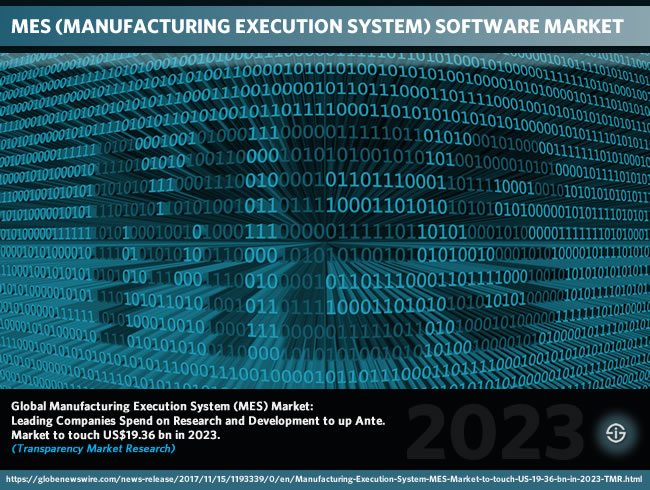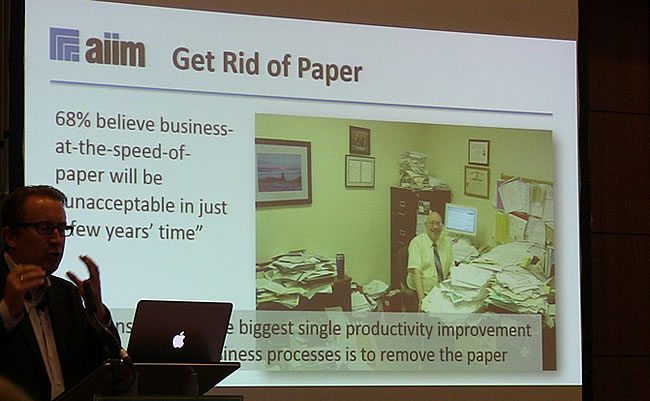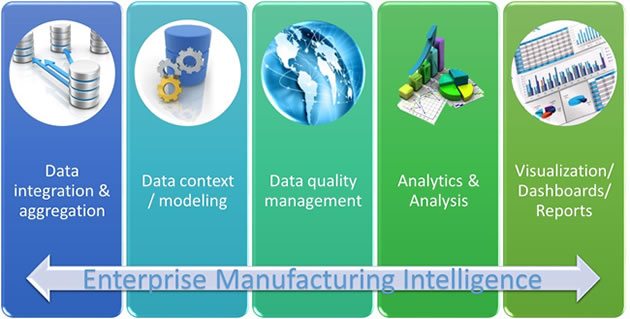A look at drivers and forecasts regarding manufacturing execution systems (MES): trends and predictions for the global MES software market against the backdrop of manufacturing industry challenges and IT/OT convergence.
As mentioned in our Industry 4.0 article most manufacturers are only in the first stages of their Industrial Internet journey with a focus on optimization, automation and other internal goals. Improving customer experience is cited a lot as well and of course there are examples of companies who lead the way and are truly innovating or transforming in an end-to-end way.
IoT is facilitating advancements in cloud computing, industrial mobility, and big data analytics. This in turn is leading to emergence of next-generation MES enabled with real time data analysis (Transparency Market Research)
Transformation happens at different speeds. It’s a topic we often discussed. IoT and several technologies are on everyone’s radar but the speed at which the digital transformation of manufacturing and industrial sectors happens differs a lot. As mentioned in our articles on manufacturing technology evolutions and in our article on manufacturing execution systems, for many companies there are still quite some challenges left to solve on levels of reducing the usage of paper-intensive processes, dealing with legacy systems, advancing the integration of IT and OT (not just on the technology level) and far more. That’s a complex reality one can’t ignore an isn’t a token that manufacturers and industrial markets are slower.
This is even more so if you start looking at contextual factors such as region (and cost of labor, local regulations, etc.), type of manufacturing (process manufacturing, discrete manufacturing,…) and exactly what industry we are in (automotive, chemical, you name it).

Removing paper based systems remains a driver for the MES software market in some regions and areas
The matter of the fact is that it is normal that many companies are still in the early stages of their industrial transformation journey and first looking at immediate goals such as removing slow paper-based processes, cost reductions, increasing automation and enhancing productivity.
With the overall manufacturing industry performing very well in several regions the pressure is on to achieve these goals, further strengthened by myriad factors such as the digital and smart supply chain, changing customer expectations and the fact that in all manufacturing segments and industrial markets there are those who are ahead which means even higher competition.
When analysts point at the future of ERP and the rising adoption of Intelligent ERP they are many years ahead and mainly talk about the largest manufacturers. When research shows that manufacturers are planning investments in Industrial IoT the respondents often are larger manufacturers too.
Traditional paper-based record keeping systems are liable to human errors. To eliminate them, organizations are increasingly resorting to advanced software based solutions such as MES (TMR analyst)
It seems like yesterday that we were at an even of AIIM (the association of information management professionals) several years ago to hear once again that paper is slowing down digital transformation. Well, it still is and remains a challenge for many manufacturers in 2018 too. So, it shouldn’t come as a surprise that in many areas there is still a focus on manufacturing execution systems from the paperless operations perspective.

Automation for manufacturing process optimization as the main MES software market driver
All this of course doesn’t mean that the pressure and rationale to increase efficiency of production processes and step up their industrial transformation efforts isn’t felt by all manufacturers. Well, on the contrary.
In fact, one of the major factors in the evolutions of the MES software market for the next years is that increasing need of manufacturers to improve efficiency (and thus further automate) and, certainly in some regions, the mentioned shift to paperless operations, thereby reducing and ideally avoiding human errors while speeding up processes as tends to be the case in less paper-intensive environments.
The number one reason for implementing MES is to improve performance (Arc Advisory Group)
On top of that there are the many technological evolutions which are both challenges and opportunities, the mentioned regulations that differ per region and industry and the demand for better, easier, more integrated and future fit manufacturing execution systems that offer the advanced integration capabilities that aren’t just needed in general but also needed with the advent and increasing importance of the many technologies that are being adopted by manufacturers, whether it’s Industrial IoT, advanced analytics, digital twin technology, additive manufacturing or whatever may be on the agenda of manufacturers in this long list of technological evolutions.
It probably doesn’t come as a surprise that these changing demands and technological evolutions aren’t just strongly influencing the MES software market but the overall manufacturing systems ecosystem, from the field level and PLCs to SCADA software and, in general, SCADA systems to the mentioned evolutions in ERP.
MES software vendors: the market and the priorities
MES software vendors are responding to demands and, in the case of the stronger and/or more forward thinking players investing quite a lot in research and development in a MES software market that continues to be one of not just technological innovation but also of mergers and acquisitions.
In a nutshell it’s also what Transparency Market Research says in an announcement, released on November 15, 2017, with regards to a report regarding the MES software market. Although the report is from 2016, the announcement and report page do contain many of the MES software market drivers and evolutions we’ve mentioned previously and which we find back in analysis from companies, ranging from IDC and Gartner to Arc Advisory Group.
Fuelling the global market for manufacturing execution system (MES) market is the pressing need of the manufacturing sector to up the efficacy of production processes through automation. Further, regulation compliances in tightly regulated industries such as pharmaceutical and food and beverages is also pushing up demand for automation, which again is proving beneficial to the market (TMR PR)
According to the Transparency Market Research report the global MES software market is expected to reach a value of $19.36 bn in 2023 with the traditional well-entrenched leaders not just dominating it but also strongly investing in R&D to enhance their solutions for all the mentioned reasons (and certainly also the fact that many legacy systems do need architectural changes as they weren’t really conceived for this new world of Industrial IoT).
To further complete their offerings and strengthen their positions MES software vendors also keep looking for strategic mergers and acquisitions as mentioned. To put the forecasted value of the global MES software market as predicted by Transparency Market Research in perspective: according to the company the market was valued at $7.86 bn in 2014 and between 2015 and 2025 is expected to grow at a double-digit CAGR of 11.1 percent.
MES is getting more connected and smarter. MES is a nexus solution for the digital transformation. (Janice Abel, ARC)
Regardless of the numbers and, taking into account the technological evolutions with regards to manufacturing execution systems and even the very role they will play in a rapidly changing market as explained in our manufacturing execution systems article, fact is that the various mentioned evolutions and drivers are all valid, again with regional differences.
Some additional findings from the MES software report:
- Demand for paperless operations mainly comes from developing regions.
- High initial upfront investments for the installation of manufacturing systems restrains growth of the global MES software market. That’s where cloud-based MES comes in the picture as well.
- Complexities in the installation of MESs is another MES software market growth inhibitor (and hopefully is part of those R&D investments).
- Advancements in IoT pave new opportunities for the key players operating in the global manufacturing execution system (MES) market (and hopefully new technologies and new demands see the emergence of more new solutions and players that truly understand the challenges and needs of customers although here as well established MES software vendors will defend their positions through R&D and M&A activities)
Smart MES: the convergence of IT and OT as the key MES software market driver
You can find more research findings regarding the MES software market, from among others IDC, Gartner and ARC Advisory Group in our manufacturing execution system overview.
However, let’s take a look at the bigger picture and additional drivers with the help of Janice Abel from ARC Advisory Group. In a blog post Janice writes that MES is a critical technology for achieving goals such as driving waste out of their operations by utilizing better tools to eliminate silos, simplifying and improving workflow and standardizing on technologies that help reduce costs and improve sustainability.
The global manufacturing execution system (MES) market is consolidated on account of a handful of well-entrenched players dominating it. Such leading players managed to establish a stronghold through durability, quality, and reliability of their products achieved through technological innovations. One of the noticeable trends in the market is the increasing allocations for research and development by such big names. (TMR PR)
Moreover, MES supports quality management and traceability, regulatory compliance, more efficient planning and scheduling, and manufacturing intelligence and analytics. These are all drivers.
And the main driver in a nutshell? The convergence of IT and OT as MES, how else could it be, is getting smarter as you can read here.

Top image: Shutterstock – Copyright: Profit_Image – All other images are the property of their respective mentioned owners.

